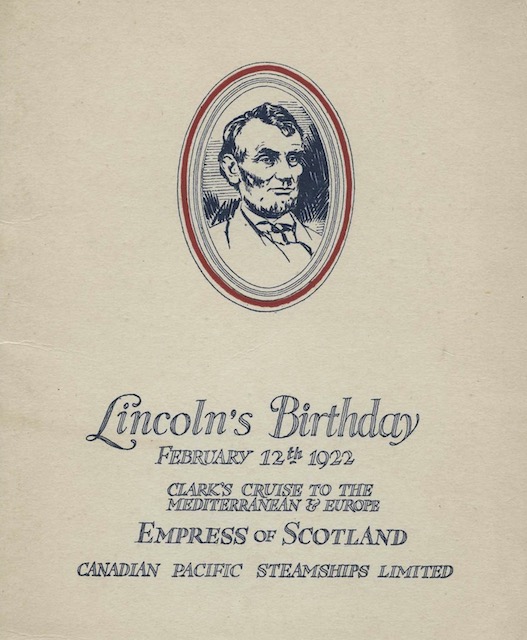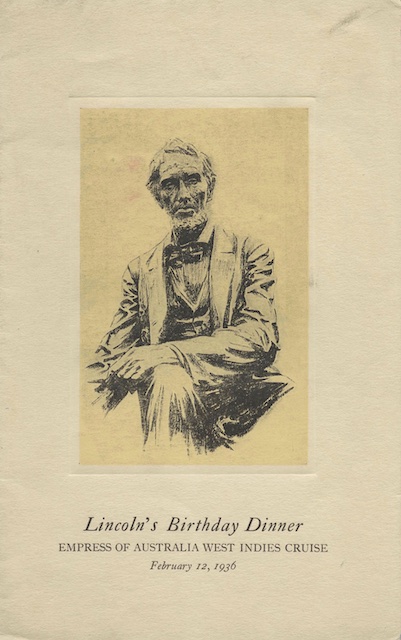Why would a Canadian company celebrate a U.S. president on one of its steamship menus? One answer is that a lot of its customers may have come from Boston, New York, and other U.S. cities that admired Lincoln (and not many from Atlanta, Columbia, and other U.S. cities that considered Lincoln a tyrant).
 Click image to view and download a PDF of this menu from the University of British Columbia Chung collection.
Click image to view and download a PDF of this menu from the University of British Columbia Chung collection.
Probably just as important was that fact that ocean voyages were inherently boring. Unlike a train trip with its constantly changing scenery outside of every window, the view from trans-oceanic steamships much of time was little more than a flat ocean in all directions. To make trips more exciting, steamship companies used any excuse to have a party, including, of course, Christmas and New Years, but also such dates as Robert Burns’ birthday.
The menu above is from a 1922 European and Mediterranean cruise by the Empress of Scotland. In keeping with the Lincoln theme, the music programme includes several American pieces including two marches by John Philip Sousa and several American songs. One, “My Curly-Headed Baby,” was actually written by an Australian named George Clutsam (misspelled Clutson on the menu). Another, “By the Swanee River,” was by an English songwriter named William Henry Myddleton (misspelled Middleton on the menu).
Unlike some other menus, the items on this one don’t have a particularly American flavor. The appetizer is marmite, which wasn’t invented until 37 years after Lincoln died and never caught on in the United States. One of the desserts is English plum pudding, again not an American dish.
 Click image to view and download a PDF of this menu from the University of British Columbia Chung collection.
Click image to view and download a PDF of this menu from the University of British Columbia Chung collection.
The second menu is from a 1936 cruise to the West Indies by the Empress of Australia. The musical selections listed on this menu all seem to be American. However, the opening number — a John Philip Sousa march called King Cotton — might have been in questionable taste considering the role cotton played in leading to the Civil War.
The menu is also more Americanized, or at least is made to appear so by adding American names to what might have been otherwise ordinary foods. Thus, diners could choose between turtle soup Jefferson and cream of tomato soup American. Entrées included sweetbreads Lincoln and sirloin of beef Springfield. Is there any evidence that cauliflower Mary Todd is anything like the cauliflower that Mary Todd might have prepared or eaten? A dessert called pear glacé Nancy Hanks seems especially unlikely considering that there is little documentation of what Nancy Hanks, Abraham Lincoln’s mother, ever ate in her lifetime.
